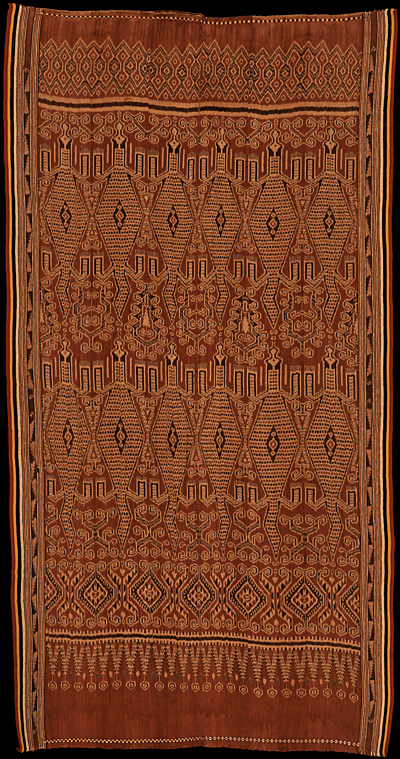| |
 
 | | | |
311 Borneo, Kalimantan
Pua (blanket)  
| | Locale: | Kantu (Kantuk, Kantu'), or Iban with Kantu neighbours. Somewhere upriver, far from trading posts. | | Period: | 1930-1940 | | Yarn: | Cotton, hand-spun, medium - plus accent stripes in commercial cotton | | Technique: | Warp ikat | | Panels: | 2 | | Size: | 119 x 237 cm (3' 10" x 7' 9") LW: 1.99 | | Weight: | 1090 g (38.4 oz), 386 g/m2 (1.26 oz/ft2) | | Design: | One of the many variants of buah baya, crocodile pattern. Two rows of six crocodiles each, all facing the same way. While the borders with their alternating light and dark triangles are a Kantu hallmark, the design is not typically Kantu but rather shows Iban influence. One design element that was drawn in a typically Kantu style is the hourglass shape, actually representing the flower stalk of sago palm, that fills the interstices between the diamond shapes near the bottom. Creating the shapes with alternating light and dark triangles is a characteristic Kantu technique. | | Comment: | Intricate design with very clear drawing. Presumably the cloth was ikated by a weaver on the western edge of the Kantu area, close to Sarawak, bordering Iban territory. Made in the last period when such quality was still produced. From European collection. | | Background: | Chapters on Borneo and Kalimantan. | | Sources: | Very similar design on Iban pua in Edric Ong, Pua, Iban Weavings of Sarawak, P8, except that there the crocodiles are facing each other, and that the border is Iban, not Kantu.The crocodile motif is also similar to that on a pua shown on P5, except that on that example there is only one row row of the animals rather than two. It also has a similar row of lozenges near the bottom, which according to Ong could represent 'lelingkok semerai sungai' - crossing back and forth across a river. The flower-like stalks in between (drawn in the Kantu style) represent the sago that grows on the river bank. Similar to pua in Langewis and Wagner, Decorative Art in Indonesian Textiles, Colour Plate II, except that there, again, the crocodiles are facing each other, and that the elaborate border is Iban, rather than Kantu. | | |

©Peter ten Hoopen, 2024
All rights reserved.
|
|


